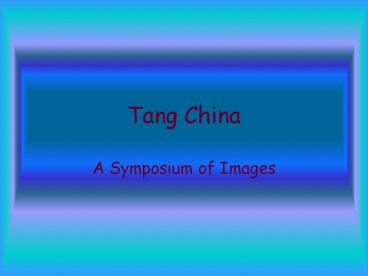Tang China - PowerPoint PPT Presentation
1 / 13
Title:
Tang China
Description:
Musicians and actors were of celebrity status and great ones were invited to the ... A carefree style has no fixed directions. Geometric. A gracefully executed work ... – PowerPoint PPT presentation
Number of Views:147
Avg rating:3.0/5.0
Title: Tang China
1
Tang China
- A Symposium of Images
2
Art in Tang China
- Tang era a golden age of China
- Art and foreign relations prospered
- Best known for the development of many forms-
painting, sculpture, pottery, calligraphy, music,
dance, and literature
3
Three color ware, or sancai, was one of the
greatest contributions of the Tang dynasty. No
dynasty before or after them have done this.
Yellow, green and white were usually the colors
used, although some sancai used two or four
colors.
4
This Period experienced long periods of peace and
prosperity. Articles of religious use were
abundant during the Tang Dynasty as a result of
the Buddhist influence of the Period.
5
The drinking of both tea and wine were commonly
enjoyed past times during the Tang Dynasty. For
centuries, business dealings had often been
concluded by drinking a cup of tea. As the social
amenities of the time grew in popularity, the
evening hours found the drinking of tea supported
by the drinking and toasting of wines as well. We
see the introduction of gorgeous tea pots and
wine jars developing during this period as a
result of the social customs.
6
There were schools for performing arts
everywhere. These schools were dedicated to full
time practice of singing, dancing, and music.
Musicians and actors were of celebrity status and
great ones were invited to the imperial palace to
entertain the emperor. There was even a musical
school on the palace grounds itself.
7
Calligraphy is an ancient art form. It is an
abstract art form and to appreciate the beauty of
it, one should notice the balance of characters,
the carefree strokes, the fluidity of the
writing, and the lightening quick speed the
artists do them in. This is the only surviving
work of the great Tang poet Li Bai. Calligraphy
can be done as poetry by itself, but it usually
is a poem accompanying a traditional painting.
8
A gracefully executed work has no
peer.
Bold yet fluid -
Balance
Formal
Expressive
Playful
9
An exuberant work full of feeling and
vigor.
A carefree style has no fixed directions
Lighting quick
Geometric
A gracefully executed work
10
Tomb Treasures
During the reign of the Chinese dynasties, the
emperors believed that death to be a prolonged
version of life. Elaborate tombs were built to
mirror their lavish lifestyles for their
after-death palaces. The Qianlong tomb of the
Tang dynasty is a joint tomb of Emperor Gaozong
and Empress Wu Zetian. There are hills upon hills
of tri-color pottery and statues.
11
Women of the Tang dynasty were fortunate enough
to live during a time of open-mindedness and
liberal ideas. A couple who wished to divorce may
do so without punishment if it was based on
mutual agreement. Women could remarry and
intermarriage could exist between different
ethnic groups. Tang women had the chance to learn
military skills, history, and politics. They
enjoyed having independent social statuses and
could drink wine and sing at taverns in public if
they wished.
12
Empress Wu
Empress Wu Zetian was the only female monarch of
China, and remains the most remarkable,
influential and mysterious woman in Chinese
history. She placed great importance on the
development of agriculture and listened to ideas
of her critics. She had the support of her loyal
administration and late Tang China prospered
under her reign. When she was bad, she could be
ruthless, not even hesitating to murder her own
son to secure her position! She resorted to
Buddhism to cleanse herself of her sins.
13
The End































